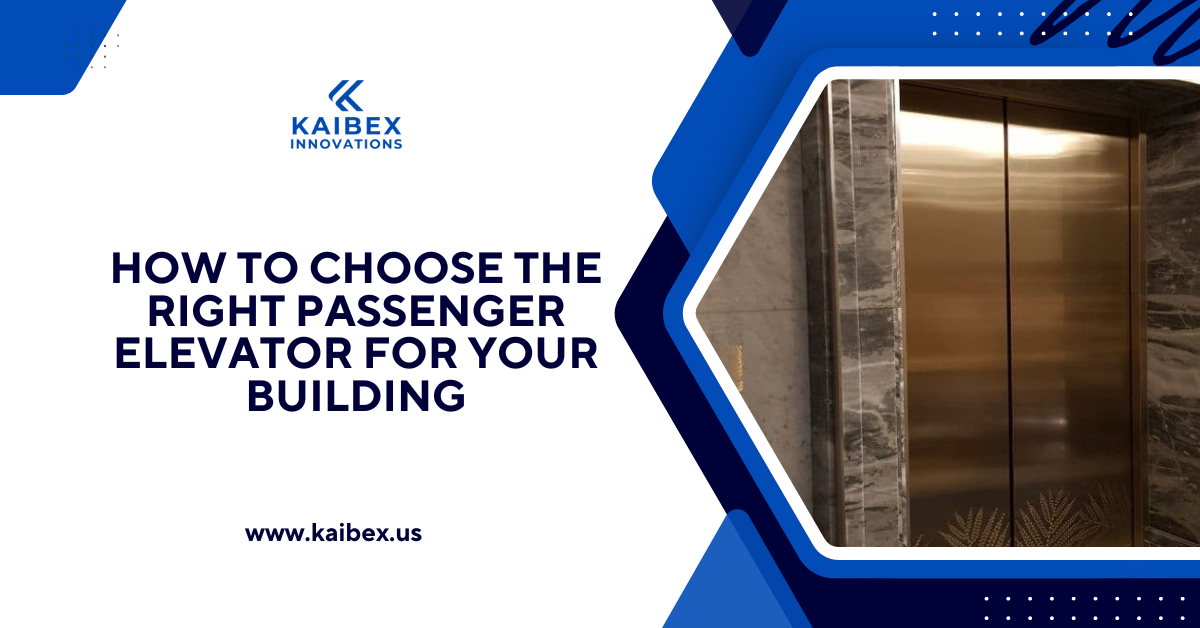How to Choose the Right Passenger Elevator for Your Building

Table of Contents
ToggleIntroduction
Passenger elevators play a crucial role in enhancing convenience, accessibility, and efficiency in buildings. Whether it’s a residential complex, commercial space, or a high-rise tower, choosing the right passenger elevator is essential for smooth operations and safety. With various types, sizes, and features available, selecting the best one can be overwhelming. This guide outlines ten important factors to consider before making your decision.
1. Determine the Purpose and Usage of the Passenger Elevator

Before selecting an elevator, it’s essential to understand its primary use. Will it serve a residential building, a corporate office, or a commercial space? Residential elevators typically handle light to moderate traffic, while office or mall elevators require higher capacity and durability. Additionally, the number of floors in the building and the expected daily usage will help determine the elevator’s specifications. Understanding these aspects ensures that the elevator meets the building’s demands efficiently.
2. Consider the Capacity and Size Requirements
The capacity of a passenger elevator is a vital factor to consider. Standard elevators range from small 4-person lifts to large models that can accommodate 20+ passengers. Assess the daily foot traffic and peak-hour loads to choose an elevator with the right weight capacity and space. Oversized elevators may lead to unnecessary energy consumption, while undersized ones can result in overcrowding and discomfort.
3. Evaluate Speed and Travel Distance

Elevator speed varies based on building height and usage. Low-rise buildings (2-5 floors) typically require speeds of 0.5 to 1.5 meters per second, whereas high-rise buildings need faster elevators exceeding 2.5 meters per second. Additionally, smooth acceleration and deceleration are important for passenger comfort. Selecting an elevator with the appropriate speed ensures efficiency and reduces wait times.
4. Focus on Safety Features and Compliance
There are three main types of passenger elevators:
Hydraulic Elevators: Suitable for low- to mid-rise buildings, cost-effective but slower.
Traction Elevators: Ideal for mid- to high-rise buildings, offering faster speeds and better energy efficiency.
Machine-Room-Less (MRL) Elevators: Space-saving and energy-efficient, perfect for modern buildings with limited space. Understanding the pros and cons of each type helps in making the right choice.
5. Choose Between Machine-Room and Machine-Room-Less Elevators

Traditionally, elevators required a separate machine room to house the motor and control systems. However, modern machine-room-less (MRL) elevators integrate these components within the shaft, saving valuable building space. While MRL elevators offer space efficiency and lower energy consumption, traditional machine-room elevators are known for their reliability and easier maintenance. Weigh the pros and cons before making a decision.
6. Evaluate Energy Efficiency and Sustainability
Modern passenger elevators come with energy-efficient technologies that reduce operational costs and environmental impact. Features like LED lighting, regenerative drives, and automatic shutdown when not in use help save electricity. Opting for an eco-friendly elevator ensures long-term savings and sustainability.
7. Consider the Speed and Travel Distance
 The speed of a passenger elevator depends on the building height and traffic requirements. Residential buildings generally need speeds of 0.5 – 1.5 m/s, while commercial towers require high-speed elevators of up to 3 – 6 m/s. Choosing the right speed ensures smooth and quick transportation for users.
The speed of a passenger elevator depends on the building height and traffic requirements. Residential buildings generally need speeds of 0.5 – 1.5 m/s, while commercial towers require high-speed elevators of up to 3 – 6 m/s. Choosing the right speed ensures smooth and quick transportation for users.
8. Look for Smart and Advanced Features
Technology plays a crucial role in enhancing elevator functionality. Some advanced features to consider include:
Touchless or biometric access
Destination control systems
Smartphone-based operation
Real-time monitoring and predictive maintenance These features improve convenience, security, and efficiency.
9. Assess Maintenance and After-Sales Support
 Regular maintenance ensures a passenger elevator remains in top condition and operates safely. Choose a reputable manufacturer that provides reliable after-sales support, easy availability of spare parts, and 24/7 maintenance services to minimize downtime.
Regular maintenance ensures a passenger elevator remains in top condition and operates safely. Choose a reputable manufacturer that provides reliable after-sales support, easy availability of spare parts, and 24/7 maintenance services to minimize downtime.
10. Budget and Installation Costs
The cost of a passenger elevator varies depending on its type, features, and brand. While budget is an important factor, prioritize quality and durability over cost savings. Investing in a high-quality elevator reduces maintenance expenses and ensures long-term reliability.
Conclusion
Choosing the right passenger elevator for your building requires careful consideration of multiple factors, including capacity, safety, efficiency, and cost. By evaluating your building’s requirements and selecting the best-suited model, you can ensure a smooth, safe, and reliable transportation experience for users. Whether for a residential, commercial, or high-rise building, a well-chosen passenger elevator enhances convenience, security, and value.
Have questions about your next renovation project? We’ve got answers. Let’s do this together.
Follow us on Instagram and YouTube.

Leave a Reply